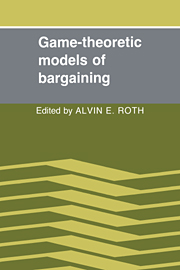Book contents
- Frontmatter
- Contents
- List of contributors
- Preface
- Chapter 1 Editor's introduction and overview
- Chapter 2 Disagreement in bargaining: Models with incomplete information
- Chapter 3 Reputations in games and markets
- Chapter 4 An approach to some noncooperative game situations with special attention to bargaining
- Chapter 5 Infinite-horizon models of bargaining with one-sided incomplete information
- Chapter 6 Choice of conjectures in a bargaining game with incomplete information
- Chapter 7 Analysis of two bargaining problems with incomplete information
- Chapter 8 Sequential bargaining mechanisms
- Chapter 9 The role of risk aversion in a simple bargaining model
- Chapter 10 Risk sensitivity and related properties for bargaining solutions
- Chapter 11 Axiomatic theory of bargaining with a variable population: A survey of recent results
- Chapter 12 Toward a focal-point theory of bargaining
- Chapter 13 Bargaining and coalitions
- Chapter 14 Axiomatic approaches to coalitional bargaining
- Chapter 15 A comment on the Coase theorem
- Chapter 16 Disclosure of evidence and resolution of disputes: Who should bear the burden of proof?
- Chapter 17 The role of arbitration and the theory of incentives
Chapter 17 - The role of arbitration and the theory of incentives
Published online by Cambridge University Press: 23 September 2009
- Frontmatter
- Contents
- List of contributors
- Preface
- Chapter 1 Editor's introduction and overview
- Chapter 2 Disagreement in bargaining: Models with incomplete information
- Chapter 3 Reputations in games and markets
- Chapter 4 An approach to some noncooperative game situations with special attention to bargaining
- Chapter 5 Infinite-horizon models of bargaining with one-sided incomplete information
- Chapter 6 Choice of conjectures in a bargaining game with incomplete information
- Chapter 7 Analysis of two bargaining problems with incomplete information
- Chapter 8 Sequential bargaining mechanisms
- Chapter 9 The role of risk aversion in a simple bargaining model
- Chapter 10 Risk sensitivity and related properties for bargaining solutions
- Chapter 11 Axiomatic theory of bargaining with a variable population: A survey of recent results
- Chapter 12 Toward a focal-point theory of bargaining
- Chapter 13 Bargaining and coalitions
- Chapter 14 Axiomatic approaches to coalitional bargaining
- Chapter 15 A comment on the Coase theorem
- Chapter 16 Disclosure of evidence and resolution of disputes: Who should bear the burden of proof?
- Chapter 17 The role of arbitration and the theory of incentives
Summary
Introduction
Recent years have seen the parallel but largely independent development of two literatures with closely related concerns: the theory of arbitration and the theory of incentives. Most of the theoretical arbitration literature seeks to predict and compare the allocative effects of the simple compulsory-arbitration schemes frequently used to resolve public-sector bargaining disputes in practice. Crawford (1981) provides a general introduction and a brief survey of this area. Sample references include Donn (1977), Crawford (1979, 1982a, 1982b), Farber and Katz (1979), Farber (1980), Bloom (1981), Hirsch and Donn (1982), Brams and Merrill (1983), and Donn and Hirsch (1983). These papers draw on, and give some references to, the large empirical and institutional arbitration literature. The incentives literature concerned directly with bargaining focuses instead on the theoretical limits of mechanism design in environments with asymmetric information. The papers by Kalai and Rosenthal (1978), Rosenthal (1978), Myerson (1979, 1983), Holmström (1982), Holmström and Myerson (1983), Myerson and Satterthwaite (1983), Samuelson (1984), and Crawford (1985), are a representative sample.
Although both literatures have the same goal – achieving better bargaining outcomes – this difference in focus, together with differences in style and analytical technique, has almost completely shut down communication between them, with discernible adverse effects on both. On the one hand, a large body of ad hoc, application-oriented analysis and measurement has developed in arbitration without recourse to carefully specified and worked-out models.
- Type
- Chapter
- Information
- Game-Theoretic Models of Bargaining , pp. 363 - 394Publisher: Cambridge University PressPrint publication year: 1985
- 2
- Cited by



